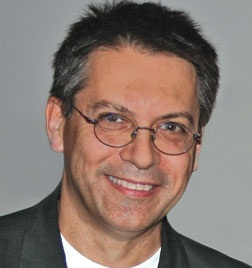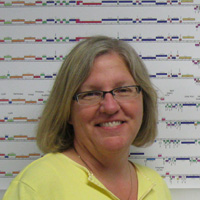Dr. Graham Hatfull
Eberly Family Professor, HHMI Professor
Dr. Hatfull received his Ph.D. in 1981 with Willie Donachie at the University of Edinburgh, Scotland, performed postdoctoral studies with Nigel Grindley at Yale University and with Fred Sanger at the MRC, and joined the Department of Biological Sciences at the University of Pittsburgh in 1988.
Dr. Hatfull's professional interests center around the study of Mycobacterium tuberculosis, the causative agent of tuberculosis. With approximately one third of the world's population infected and roughly 3 million deaths per year, TB is a formidable pathogen. Dr. Hatfull uses Mycobacterium smegmatis as the model organism for many of his lab's studies.
Mycobacteriophages—viruses that infect the mycobacteria—lie at the heart of Dr. Hatfull's strategy to understand mycobacterial genetics. Phages are easy to grow and manipulate and offer advantages over working with the slow-growing mycobacteria (such as M. tuberculosis) that can take up to a month to produce a colony on an agar plate. Phages are also rich sources of a wide variety of potential genetic and molecular tools that can be used to study—and to modify—their bacterial hosts.
gfh@pitt.edu
University of Pittsburgh
Hatfull Lab Home
Phage Publications (click to view)
Pope WH et al 2011, PLoSOne: Expanding the diversity of mycobacteriophages: Insights into genome architecture and evolutionHatfull GF 2010, Annual Review of Microbiology: Mycobacteriophages: Genes and Genomes.Hatfull GF et al 2010, Journal of molecular biology: Comparative genomic analysis of 60 Mycobacteriophage genomes: genome clustering, gene acquisition, and gene size.Piuri M, Jacobs WR, Hatfull GF 2009, PloS one: Fluoromycobacteriophages for rapid, specific, and sensitive antibiotic susceptibility testing of Mycobacterium tuberculosis.Ghosh P, Bibb LA, Hatfull GF 2008, Proceedings of the National Academy of Sciences of the United States of America: Two-step site selection for serine-integrase-mediated excision: DNA-directed integrase conformation and central dinucleotide proofreading.Hatfull GF, Cresawn SG, Hendrix RW 2008, Research in microbiology: Comparative genomics of the mycobacteriophages: insights into bacteriophage evolution.van Kessel JC, Hatfull GF 2008, Methods in molecular biology (Clifton, N.J.): Mycobacterial recombineering.van Kessel JC, Hatfull GF 2008, Molecular microbiology: Efficient point mutagenesis in mycobacteria using single-stranded DNA recombineering: characterization of antimycobacterial drug targets.van Kessel JC, Marinelli LJ, Hatfull GF 2008, Nature Reviews Microbiology: Recombineering mycobacteria and their phages.van Kessel JC, Hatfull GF 2007, Nature methods: Recombineering in Mycobacterium tuberculosis.Ghosh P, Wasil LR, Hatfull GF 2006, PLoS biology: Control of phage Bxb1 excision by a novel recombination directionality factor.Hatfull GF et al 2006, PLoS genetics: Exploring the mycobacteriophage metaproteome: phage genomics as an educational platform.Piuri M, Hatfull GF 2006, Molecular microbiology: A peptidoglycan hydrolase motif within the mycobacteriophage TM4 tape measure protein promotes efficient infection of stationary phase cells.Bibb LA, Hancox MI, Hatfull GF 2005, Molecular microbiology: Integration and excision by the large serine recombinase phiRv1 integrase.Ghosh P, Pannunzio NR, Hatfull GF 2005, Journal of molecular biology: Synapsis in phage Bxb1 integration: selection mechanism for the correct pair of recombination sites.Ghosh P, Kim AI, Hatfull GF 2003, Molecular cell: The orientation of mycobacteriophage Bxb1 integration is solely dependent on the central dinucleotide of attP and attB.Lewis JA, Hatfull GF 2003, Journal of molecular biology: Control of directionality in L5 integrase-mediated site-specific recombination.Bibb LA, Hatfull GF 2002, Molecular microbiology: Integration and excision of the Mycobacterium tuberculosis prophage-like element, phiRv1.Jain S, Hatfull GF 2000, Molecular microbiology: Transcriptional regulation and immunity in mycobacteriophage Bxb1.Lewis JA, Hatfull GF 2000, Molecular microbiology: Identification and characterization of mycobacteriophage L5 excisionase.Peña CE, Kahlenberg JM, Hatfull GF 2000, Proceedings of the National Academy of Sciences of the United States of America: Assembly and activation of site-specific recombination complexes.Peña CE, Kahlenberg JM, Hatfull GF 1999, Journal of bacteriology: Protein-DNA complexes in mycobacteriophage L5 integrative recombination.Pedulla ML, Hatfull GF 1998, Journal of bacteriology: Characterization of the mIHF gene of Mycobacterium smegmatis.Peña CE, Kahlenberg JM, Hatfull GF 1998, Nucleic acids research: The role of supercoiling in mycobacteriophage L5 integrative recombination.Peña CE, Stoner J, Hatfull GF 1998, Gene: Mycobacteriophage D29 integrase-mediated recombination: specificity of mycobacteriophage integration.Sarkis GJ, Hatfull GF 1998, Methods in molecular biology (Clifton, N.J.): Mycobacteriophages.Barsom EK, Hatfull GF 1997, Gene: A putative ABC-transport operon of Mycobacterium smegmatis.Fullner KJ, Hatfull GF 1997, Molecular microbiology: Mycobacteriophage L5 infection of Mycobacterium bovis BCG: implications for phage genetics in the slow-growing mycobacteria.Barsom EK, Hatfull GF 1996, Molecular microbiology: Characterization of Mycobacterium smegmatis gene that confers resistance to phages L5 and D29 when overexpressed.Hatfull GF 1996, Current topics in microbiology and immunology: The molecular genetics of Mycobacterium tuberculosis.Peña CE, Stoner JE, Hatfull GF 1996, Journal of bacteriology: Positions of strand exchange in mycobacteriophage L5 integration and characterization of the attB site.Sarkis GJ, Jacobs WR, Hatfull GF 1995, Molecular microbiology: L5 luciferase reporter mycobacteriophages: a sensitive tool for the detection and assay of live mycobacteria.Hatfull GF et al 1994, Developments in biological standardization: Bacteriophages as tools for vaccine development.Donnelly-Wu MK, Jacobs WR, Hatfull GF 1993, Molecular microbiology: Superinfection immunity of mycobacteriophage L5: applications for genetic transformation of mycobacteria.Hatfull GF, Sarkis GJ 1993, Molecular microbiology: DNA sequence, structure and gene expression of mycobacteriophage L5: a phage system for mycobacterial genetics.Lee MH, Hatfull GF 1993, Journal of bacteriology: Mycobacteriophage L5 integrase-mediated site-specific integration in vitro.Oyaski M, Hatfull GF 1992, Nucleic acids research: The cohesive ends of mycobacteriophage L5 DNA.
Dan Russell
Lab Instructor, Webmaster for phagesdb.org
Dan's current roles include building and curating phagesdb.org, and managing the sequencing of phage genomes from Roger Hendrix and Graham Hatfull's labs at the University of Pittsburgh. He has a B.S. from Cornell University in Molecular and Cellular Biology and a Master's Degree in Education from the University of Missouri. In 2008, Dan moved back to Pittsburgh, his hometown, after a 12-year absence and now works in the same department where his father was a faculty member.
Phages Found:
Avrafan,
Babsiella,
Cello,
Kugel
dar78@pitt.edu
University of Pittsburgh
Phage Publications (click to view)
Debbie Jacobs-Sera
Phagehunting Program Coordinator
Ms. Jacobs-Sera has a BSMT from the University of Pittsburgh. She worked as a microbiologist at Presbyterian University Hospital, Blood Bank Technologist at Central Blood Bank of Pittsburgh, and Pathology Assistant at Presbyterian University Hospital. Later, she received her Masters of Teaching degree from the University of Pittsburgh and taught life science and biology at the Greater Latrobe School District. While there, as her interest to import authentic science research into her lab, she found phagehunting at Dr. Hatfull's lab. In 2001, two of her students, Joe Gross and Jake Falbo, began phagehunting in the classroom laboratory. Their first phages, Rosebush, Barnyard, and Wildcat are some of the first published mycobacteriophages.
In 2004, Ms. Jacobs-Sera joined the Hatfull Lab as assistant coordinator, under the direction of Dr. Marisa Pedulla. Together, they developed a teacher professional development program and expanded the high school student outreach. Since Marisa's departure in 2006, Ms. Jacobs-Sera's best efforts have been utilized to promote and continue the ever-expanding Phagehunting Program.
For more information about teacher and student involvement in the phagehunter Program, go to the phagehunters link below.
Phages Found:
RedRock,
Rosebush
djs@pitt.edu
University of Pittsburgh
Phage Publications (click to view)
Mageeney C, et al. 2012, Journal of Virology: Mycobacteriophage Marvin: a new singleton phage with an unusual genome organization.Cresawn SG, et al. 2011, BMC Bioinformatics: Phamerator: a bioinformatic tool for comparative bacteriophage genomics.Pope WH et al 2011, PLoSOne: Expanding the diversity of mycobacteriophages: Insights into genome architecture and evolutionPope WH, Ferreira CM, Jacobs-Sera D, et al 2011, PLoS One: Cluster K mycobacteriophages: insights into the evolutionary origins of mycobacteriophage TM4Hatfull GF et al 2010, Journal of molecular biology: Comparative genomic analysis of 60 Mycobacteriophage genomes: genome clustering, gene acquisition, and gene size.Sampson T et al 2009, Microbiology (Reading, England): Mycobacteriophages BPs, Angel and Halo: comparative genomics reveals a novel class of ultra-small mobile genetic elements.Morris P et al 2008, Journal of bacteriology: Genomic characterization of mycobacteriophage Giles: evidence for phage acquisition of host DNA by illegitimate recombination.Pham TT et al 2007, Microbiology (Reading, England): Comparative genomic analysis of mycobacteriophage Tweety: evolutionary insights and construction of compatible site-specific integration vectors for mycobacteria.Hanauer DI, et al. 2006, Science: Inquiry learning. Teaching scientific inquiry.Hatfull GF et al 2006, PLoS genetics: Exploring the mycobacteriophage metaproteome: phage genomics as an educational platform.Pedulla ML et al 2003, Cell: Origins of highly mosaic mycobacteriophage genomes.
Dr. Welkin H Pope
Research Assistant Professor, Hendrix and Hatfull Labs
A native of Cape Cod, Welkin received a BS in Biology from the Massachusetts Institute of Technology in 2000 and a PhD in Biological Oceanography from the MIT-Woods Hole Oceanographic Institution Joint Program in 2005. She did her graduate work in the laboratory of Prof. Jonathan King at MIT, where she learned to love bacteriophage of all shapes and sizes. Her thesis work focused on the physical and genomic characterization of Syn5, a cyanophage of marine Synechococcus.
In 2005, she moved to Pittsburgh (the phage center of the universe) to work with Roger Hendrix and Graham Hatfull at the Pittsburgh Bacteriophage Institute at the University of Pittsburgh, and now primarily focuses on comparative genomics. With the adoption and nationalization of Dr. Hatfull's phagehunting program by the Howard Hughes Medical Institute's Science Education Alliance, Welkin became highly involved in the coordination of scientific efforts between the SEA's member schools and the PBI.
To date, she has worked with phages of Salmonella typhiimurium, Escherichia coli, Bacillus megaterium, marine Synechococcus, marine Prochlorococcus, Mycobacterium smegmatis, Mycobacterium tuberculosis, as well as some unknown hosts, and she is always happy to acquire new ones.
welkin@pitt.edu
University of Pittsburgh
Phage Publications (click to view)
Dr. Viknesh Sivanathan
HHMI Program Officer-SEA
Vic Sivanathan is primarily responsible for the Science Education Alliance, a program that offers educators models of research-based curricula to engage college students in authentic research as early as possible in their academic careers. Trained as a biochemist and a microbiologist, Vic also gained extensive teaching experience during his time at Oxford and Harvard, and has applied his research as a tool for teaching college students.
sivanathanv@hhmi.org
Howard Hughes Medical Institute




